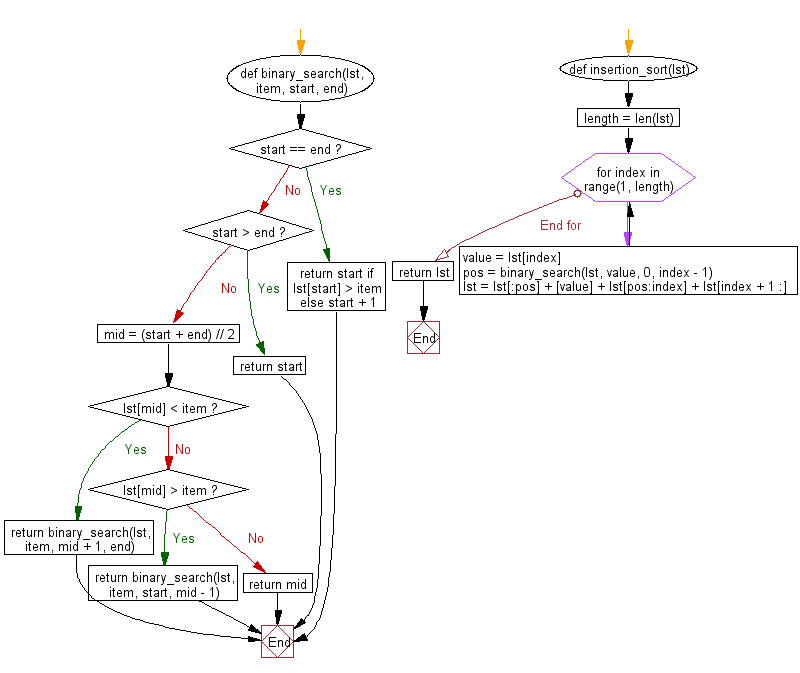Python: Sort unsorted numbers using Timsort
25. Timsort
Write a Python program to sort unsorted numbers using Timsort.
From Wikipedia:
Timsort is a hybrid stable sorting algorithm, derived from merge sort and insertion sort, designed to perform well on many kinds of real-world data. It was implemented by Tim Peters in 2002 for use in the Python programming language. The algorithm finds subsequences of the data that are already ordered (runs) and uses them to sort the remainder more efficiently. This is done by merging runs until certain criteria are fulfilled. Timsort has been Python's standard sorting algorithm since version 2.3.
Sample Solution:
Python Code:
#Ref:https://bit.ly/3qNYxh9
def binary_search(lst, item, start, end):
if start == end:
return start if lst[start] > item else start + 1
if start > end:
return start
mid = (start + end) // 2
if lst[mid] < item:
return binary_search(lst, item, mid + 1, end)
elif lst[mid] > item:
return binary_search(lst, item, start, mid - 1)
else:
return mid
def insertion_sort(lst):
length = len(lst)
for index in range(1, length):
value = lst[index]
pos = binary_search(lst, value, 0, index - 1)
lst = lst[:pos] + [value] + lst[pos:index] + lst[index + 1 :]
return lst
def merge(left, right):
if not left:
return right
if not right:
return left
if left[0] < right[0]:
return [left[0]] + merge(left[1:], right)
return [right[0]] + merge(left, right[1:])
def tim_sort(lst):
length = len(lst)
runs, sorted_runs = [], []
new_run = [lst[0]]
sorted_array = []
i = 1
while i < length:
if lst[i] < lst[i - 1]:
runs.append(new_run)
new_run = [lst[i]]
else:
new_run.append(lst[i])
i += 1
runs.append(new_run)
for run in runs:
sorted_runs.append(insertion_sort(run))
for run in sorted_runs:
sorted_array = merge(sorted_array, run)
return sorted_array
lst = [5, 9, 10, 3, -4, 5, 178, 92, 46, -18, 0, 7]
print("\nOriginal list:")
print(lst)
print("After applying Timsort the said list becomes:")
sorted_lst = tim_sort(lst)
print(sorted_lst)
lst = "Python"
print("\nOriginal list:")
print(lst)
print("After applying Timsort the said list becomes:")
sorted_lst = tim_sort(lst)
print(sorted_lst)
lst = (1.1, 1, 0, -1, -1.1)
print("\nOriginal list:")
print(lst)
print("After applying Timsort the said list becomes:")
sorted_lst = tim_sort(lst)
print(sorted_lst)
Sample Output:
Original list: [5, 9, 10, 3, -4, 5, 178, 92, 46, -18, 0, 7] After applying Timsort the said list becomes: [-18, -4, 0, 3, 5, 5, 7, 9, 10, 46, 92, 178] Original list: Python After applying Timsort the said list becomes: ['P', 'h', 'n', 'o', 't', 'y'] Original list: (1.1, 1, 0, -1, -1.1) After applying Timsort the said list becomes: [-1.1, -1, 0, 1, 1.1]
Flowchart:


For more Practice: Solve these Related Problems:
- Write a Python program to sort a list using Timsort and then output the detected runs during the sorting process.
- Write a Python script to compare the performance of Timsort with Python’s built-in sorted() on a nearly-sorted list.
- Write a Python program to implement a simplified Timsort and then verify its correctness on various datasets.
- Write a Python function to simulate Timsort by merging natural runs and then print the final sorted array.
Go to:
Previous: Write a Python program to sort a list of elements using Tree sort.
Next: Write a Python program to sort unsorted numbers using Strand sort.
Python Code Editor:
Contribute your code and comments through Disqus.
What is the difficulty level of this exercise?
Test your Programming skills with w3resource's quiz.
